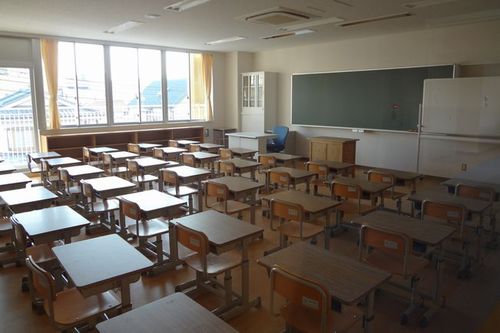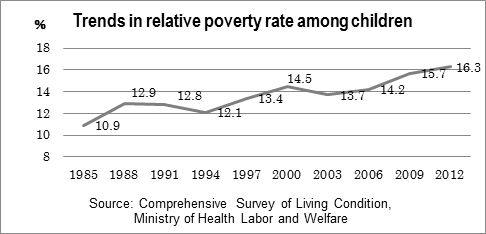October 18, 2016
Chiiki Mirai Juku : Local Communities Support Government's Tutoring Program to Fight Child Poverty in Japan
Keywords: Education Newsletter
JFS Newsletter No.169 (September 2016)

Image by Ryo FUKAsawa Some Rights Reserved.
Child poverty is attracting growing concern in Japan. It is a problem requiring serious attention, because it affects not only the health and happiness of children and their families but also their potential for higher education and better jobs in the future. This month we report on the status of child poverty in Japan, plus the Chiiki Mirai Juku Program, a tutoring program undertaken by the government to address child poverty.
Worsening Child Poverty in Japan
According to a study conducted by the Ministry of Health, Labour and Welfare, one of every six Japanese children lives in relative poverty, which means living in a household with below 50 percent of national median income. In developed countries, poverty is generally measured by relative poverty, whereas in developing countries it is measured by absolute poverty (e.g., living on less than $1.90 a day ). The poverty rate among children has been rising in Japan.

A report published by UNICEF in April 2016 stated that Japan had the eighth widest gap between the poorest and the average groups in terms of income, educational achievement, and other measures, among 41 member countries of the European Union and Organization for Economic Cooperation and Development (OECD).
Future Effects of Child Poverty
Child poverty has a great influence on the future life of a child. For example, the university graduation rate is more than 40 percent for both men and women in households not in poverty, but for households on welfare the rate is approximately 15 percent. One can see large differences between the two groups. As educational background also affects employment patterns (e.g., permanent versus part-time employment), educational disparities lead to disparities in lifetime income earned.
The Nippon Foundation published a report in December 2015 that estimated society's losses due to child poverty, with two scenarios to highlight differences in the number of university graduates, income disparities, and other parameters. In the "current scenario," poverty is left unaddressed, while in the "improved scenario" measures are taken such as providing educational assistance to 180,000 children aged 15 years living in poor households. Approximately 34,000 graduate from university in the current scenario, compared to 62,000 in the improved scenario, a difference of nearly 30,000 university graduates. The number of future permanent employees was estimated at 81,000 in the current scenario, and 90,000 in the improved scenario.
These differences lead to differences in income, because permanent employees earn more than part-time employees. The report estimated the total lifetime income (earned until the age of 64) for 180,000 children in poor households at 22.6 trillion yen (about U.S.$215 billion) in the current scenario, and 25.5 trillion yen (about $243 billion), in the improved scenario, an increase of 2.9 trillion yen (about $28 billion). These estimates show the significant differences resulting from support measures taken even just for 180,000 children.
If parents remain in poverty, their children will also be likely to grow up in poor households. This is called the cycle of poverty. In Japan, many children attend after-school tutoring programs, but this is something that poor households cannot afford. To break the vicious cycle, children also need extra assistance to learn, in addition to regular school.
Free Learning Assistance: "Chiiki Mirai Juku" Program
With this background, the Japanese government launched the Chiiki Mirai Juku program (translated roughly as "Community Tutoring School for the Future") in fiscal 2015, as a form of community-based learning assistance for children. As the name suggests, the program is implemented with the cooperation of local residents. Using local schools as a platform, the support is offered free of charge to junior high school students who have difficulty in developing study habits at home. In 2015, the Chiiki Mirai Juku program was offered in 2,000 junior high school districts, with a total budget of 200 million yen (about $1.9 million). The program can be implemented flexibly according to local needs. For example, municipalities can entrust it to private tutoring schools or non-profit organizations, etc. In addition, the program can focus on certain students or can be open to anyone.
One Chiiki Mirai Juku program is offered evenings twice a week during the school term, using classrooms in a junior high school. Seventh to ninth graders who want to participate in the program can receive learning assistance from aspiring teachers and university students. This is an example of Chiiki Mirai Juku open to any junior high school student in the district. Participating students study alone using workbooks but ask instructors when they have a question. An average of 30 students receive learning support each time. Since the number of students in the school is about 300, the program participants account for about 10 percent of the total.
Another example of Chiiki Mirai Juku targets children who have difficulty studying at home or have poor study habits. Under this program, participants are divided into two courses according to their learning levels: Mirai Juku course and standard course. The Mirai Juku course is a small-group class in which students can learn more thoroughly.
In this case, careful attention is given to the students in the Mirai Juku course who tend to fall behind at school. The program offers the two courses at the same time so that the Mirai Juku course does not stand out. The goal is to provide adequate learning support to students who need it, but to avoid having them being perceived as "poor" or "under-performing" students.
In fiscal 2016, the second year of the program, the government has set a goal to increase the number of participating school districts to 3,000, and for 2019 the target is 5,000 districts (covering half of all junior high schools in Japan). The Chiiki Mirai Juku program entered a new phase in 2016 by targeting not only junior but also senior high schools, and utilizing information and communications technologies (ICT) to accelerate learning support.
Legislation and Programs that Support Chiiki Mirai Juku
The Chiiki Mirai Juku program is offered based on various laws and programs. For example, the Act on Promotion of Policy on Poverty among Children entered into force in January 2014. Its basic philosophy is to realize a society where a child's future is not influenced by family background. In line with the legislation, the General Principles of Policy on Poverty among Children was formulated to focus on specific measures, in such areas as (1) educational support, (2) livelihood support, (3) job assistance to parents, (4) financial support, and (5) research on child poverty.
In the area of "educational support," priority measures include (1) promoting child poverty countermeasures using schools as platforms, (2) reducing the burden of educational costs, (3) promoting learning assistance to prevent the cycle of poverty, and (4) providing learning assistance focused on junior high school students who are more likely to fall behind at school. These are exactly the areas where the Chiiki Mirai Juku program is focused.
Other programs support the Chiiki Mirai Juku program from approaches other than measures against poverty. When Japan's Basic Act on Education was amended in 2006, new provisions were added concerning mutual cooperation between schools, households and local residents. To turn the legislation into practical action, efforts have been made since 2008 to set up a community-based support organization in each school district. In this scheme, local residents provide support as volunteers upon request of the schools. Many Chiiki Mirai Juku initiatives are undertaken based on these local support organizations. This is how the Chiiki Mirai Juku program has been growing in individual communities, while being connected with existing programs and organizations.
Written by Naoko Niitsu
Related
"JFS Newsletter"
- 'Good Companies in Japan' (Article No.4): 'Eightfold Satisfaction' Management for Everyone's Happiness
- "Nai-Mono-Wa-Nai": Ama Town's Concept of Sufficiency and Message to the World
- 'Yumekaze' Wind Turbine Project Connects Metro Consumers and Regional Producers: Seikatsu Club Consumers' Co-operative
- Shaping Japan's Energy toward 2050 Participating in the Round Table for Studying Energy Situations
- 'Good Companies in Japan' (Article No.3): Seeking Ways to Develop Societal Contribution along with Core Businesses


